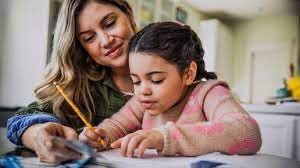

Think about it: We all write so many times everyday: email, texts, Facebook, Twitter, Instagram, brief notes, reports, letters, for example. Interestingly, although we do write all the time, when we, as parents, think of the word writing, we sometimes think of writing as difficult to attempt, even as something that seems like an impenetrable wall.
Yes, English teachers—elementary-college—teach writing. But you can help, too, and have some fun with your kids together!
If we think of all forms of writing as a mode of expression, we realize it’s not so different from sharing what we and our kids think or say on a regular basis—verbally and written. Diaries, journals, notes—ways some of us have chronicled moments in time, holiday memories, joys, and tragedies. Many American writers, journalists, artists, even scientists had and have such recordings not only to remind them of family and ideas and moments but also to rely on these memories and experiences as sources for inspiration and ideas for future projects.

The purpose of this exemplar is to encourage you to explore and discover with your kids approaches to writing together: formal, informal, conversational, and working kinds of writing they may use in their future. English teachers teach, yes. Your sharing with kids the art and act and purpose of writing, however, is not only more intimate and familial, it is also safe and secure for them. With your sharing, listening, and guiding, kids can see and experiment at home and in real time the different types and kinds of writing on a daily basis. They can understand and experience directly just how and why developing their own style and voice in writing is an important lifelong skill. In addition, their being able to chronicle and share with family moments in time can have positive impacts on all family members.
Leveraging the Obvious
Let’s begin with what seems so natural, namely, what kids think and how they express themselves on a regular basis in words through texting and other forms of social media. While this kind of writing may not at first resemble traditional or formal styles of writing, it is an important starting point for both you and your kids to recognize.

While their writing may not initially resemble what you think of as “proper,” or formal writing, it actually contains all of the necessary components formal writing requires. And, with your encouragement and sharing the writing experience with them, your kids will gain confidence. Sharing your and their ideas and thoughts along with experimenting on how they express themselves can indeed be rewarding, supportive of their writing in classes, and reaffirming—both at home and at school. Your kids realizing that you not only want to share how you write but also that you want and are interested in what they have to say will build confidence in a variety of settings: home, school, work, daily living.
Beginning and sustaining this activity relies on a foundation of three key elements which are tools for all forms of writing: Ideas, Voice, and Means of Expression. Please remember, this idea and strategy works over a sustained period of time. Sharing writing with your kids can create an entirely new relationship and experience. Now, let’s explore how you can use them.
Idea, Voice, Expression - the key elements
Idea: the starting point, either in terms of a story or ideas and questions to be shared. Essentially, these are the building blocks to what you and your kids want to say and why you want to share it.

Voice: what you and your kids bring to writing, relying on your vocabulary, regional dialect, even familiar euphemisms. Voice—yours and your child’s voice—is how you translate what each of you thinks. What you think and then how you “translate into words,” capturing and sharing your thoughts for readers: emotional, objective, descriptive, illustrative—we all rely on Voice to communicate.
Think about it: your parental voice that is cautionary is very different from your praising, empathetic, or disciplinary voices—each having its own unique and different sound/intonation, word choice, rhythm, and volume. In both writing and speaking, Voice is always present consciously and unconsciously.

Expression: the style and content of what and how you plan to write. Expression involves selecting and organizing words, thoughts, and the crafting of written elements, relying on grammar and punctuation to help present what you want to write clearly.
Using the Tools
So, how do you help your kids use these tools? Coming up with ideas and questions often seems somewhat natural for kids—their unfettered imagination, ability to suspend the necessity for undeniable proof, and, with this generation, the penchant for questioning everything. How they translate their ideas, questions, thoughts/perspectives into writing is yet on another level.
Another critical necessity of writing—that, let’s be honest, has initially daunted, even turned off—many, regardless of age: when, why, and how do you use grammar and punctuation? Believe it or not, this part really can be fun! Even painless.
Idea and Voice: Our kids are filled with ideas and not just during the holidays. Kids, especially today, are “uber” sensory-conductors—always exploring and taking in information: people, friends, family, advertisements, social media, multi-forms of entertainment, at play, at school, and sharing with friends. Encouraging your kids to talk through their ideas and thoughts with your consciously listening is a great way to start.
Journal—photo and written—Encourage kids to have their phones or a small notebook to take quick notes or capture images is always a useful tool in writing. Taking images of billboards, posters, too, can always be helpful. Periodically, have conversations with your kids, asking them to explain what they want to say and why, based on their notes and images.
A very good way of making this activity a family one is for you to have your own images and notes that you could use for later writing. Many cell phones have a Notes app or a voice recorder, using these tech-tools can easily attract kids’ interest, making them more amenable to “taking notes” and collecting images for later reference and use.
With notes and images in hand, your kids can begin thinking about writing and jotting questions they may have along the way.

Expression: Using grammar and punctuation is often difficult for kids to understand and master. And, as stated earlier, many—adults and kids—can sometimes feel uncomfortable, even intimidated when having to think consciously of grammar and punctuation. Rather than presenting these elements as rules, urge kids to look at their own existing writing—texts, messages, snapchats, emails, including the use of their emojis and other images. For example, look at the following:
- oh noooooooooooo!!!!
- :))
- how r u?
These are quite simple examples, but…they do illustrate that our kids are writing, using punctuation, and grammar to convey their own ideas, messages, and perspectives. We can express written communications in so many different ways. With the holidays approaching, thinks about joining your kids in memorializing each holiday with written projects they and you can do separately and together.

Next, after each holiday, share writings to think about how to create a document(s) to share with family, as a way of remembrance and that moment(s) in time. As you work together on your written holiday memory, discuss the how of what you want to say: the words, punctuation (or lack of standard rules), sentence structure, and images:
Example:
- Wondering if we’ll be able to go to XXXX’s home this year? Hmmmmmmm the smells from the kitchen, the leaves . . .
- I am so excited to have the holiday season upon us. Can’t wait! Family and friends and food—yea…
- Thanksgiving—turkey, pies, man o man the pies love ‘em
All of these examples reflect the way we remember not only the holidays but also significant moments in time. The sentences above illustrate how family members talk with each other as friends—relaxed, abbreviated, the mind in process on paper.

On the other hand, sometimes writing has to be more formal but, hopefully not staid: Statements of Purpose for college, job applications that often ask applicant to provide a personal graph, though formal and purpose-driven, do not have to be staid. Written documents such as these actually fair more effectively when the writer provides a more personal and descriptive touch.
Word Choice—Encourage and support kids’ ability to play on words—to allow their story to sound like them as well as what they’ve heard. Allow them to add or delete letters for effect, if they feel doing so helps readers see and understand more clearly their message.
Sentences—Think of sentences as pieces of a model or even a puzzle. They help organize the elements kids want to express and share. Sentences capture a series of related thoughts. Again, students learn in school the basic rules of periods, commas, semicolons, but also support and encourage experimenting with those rules. Sentences can be very short for effect, as well as very long for effect. And, yes, when useful, fragments can be helpful:
- Fire!
- One lazy summer’s day, many, many years ago, I remember having the time of my life, a moment in time I will never, ever, forget.
- They all gathered. Some somber. Some anxious. A few totally blank.

Paragraphs—Paragraphs are blocks of sentences which capture thoughts, expressions, and emotions. Together, paragraphs present the critical elements in telling the story kids want to share. In many ways paragraphs are like a roadmap, a guide to what you mean in your writing. Have your kids describe and show you how they would break up telling a story into paragraphs. It’s okay if for effect and the story if your child wants to make a single sentence its own paragraph. Using this writing strategy, alerts readers of the important of this thought, perspective, reaction, for example.
Punctuation marks—It is important for kids to understand punctuation marks as the natural pauses and changes in how they normally express themselves. Punctuation refers to the symbols used in sentences to make the meaning even clearer. Think of marking these phrases and the changes in writing as a reflection of how they speak and what they want to say. The marks include:
- Period
- Commas—using and not using them create the rhythm/pace for readers; the separation of ideas or elements within a sentence.
- Semicolon—connects two or more separate thoughts contained in a sentence.
- Colon—introduces an explanation or an example, a series or words, or a quotation of from what another person has said or written.
- Question mark and exclamation point
- Italics
- Ellipsis
- Dash
- Creating words: (jabberwock [Lewis Carroll], rememory [Toni Morrison] canceled, bop, drag [new Gen Z words—some included in current dictionaries]; combining words to create new ones: biopic, infomercial, Brexit, Medicare, for example
- Omitting or adding letters from beginning, middle, or end of words to recreate speech patterns: ‘bout, goin’, broththa, apahtment, for example
- Using a word as a different part of speech: I appled my ice cream. I kneed the ottoman into place.
Making It Happen
This step involves working with your kids to make their writing real; to help them understand that what they are saying is important, important enough that others will want to read. Ask them to share their text with you and then explore together your and their reaction.
Explore the word choices and talk about why they are important and necessary. Suggest they create an ongoing scrapbook, describing what they’ve written. This section becomes the key reference to both holiday memories and important moments kids want to share. Encourage kids, assuring them how their thoughts are worth sharing—with you, other family members, friends, and in other situations throughout life.
As you and kids write together, you and they can begin looking at other examples of what they consider good writing. This exercise will help kids develop further their own unique style. Urge them to look at magazines and books at home, in their school library, listen to online presentations/podcasts, and programs they view. What words and phrases do they think stand out with special meaning? As they gather these resources, encourage them to keep notes or journals where these examples can “live,” along with their thoughts/reflections about what they like and don’t like about the examples. You may even want to encourage them to share the journals with their teachers in class.
As you begin the process of writing together, keep in mind that you want to sustain this process—helping, guiding, and listening to your kids. After you have developed this routine writing activity, you and kids can talk about how you and they feel now about writing.
- What have they learned about their ability to express themselves through writing using their own, newly developed voice?
- What have you found out about writing that you discovered because you and your kids have shared this now common routine, that is actually quite unique?
- Encourage them to keep writing. Reassure them that you will continue to be a part of the activity because you want to.
- Don’t correct every jot and tittle. The aim of helping your kids to write, helping them feel more in control of their writing, and comfortable, is for them to trust that you will not be critical of their expressions, ideas, and perspectives. Remember, although so many of us write every single day, many times within the day, folks generally do not like sharing their writing for fear of being corrected.
In contrast, this kind of activity with you and your kids can have the effect of making you both feel more comfortable and assured about writing.

Remind your kids: Now it’s your turn, it’s your voice, and rely on it to express yourself in writing! And doing so together is going to be exciting, fun, and safe.
This post comes from the TODAY Parenting Team community, where all members are welcome to post and discuss parenting solutions. Learn more and join us! Because we're all in this together.
